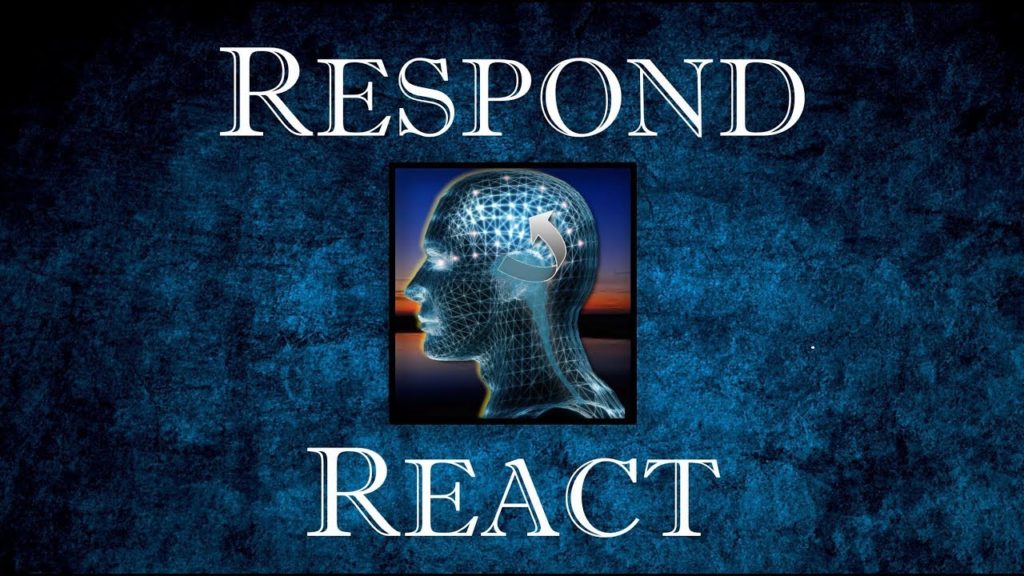Response Vs Reaction – A Mindful Difference

“Life is 10% what happens to you and 90% how you react to it.” – Charles R Swindoll
“Between stimulus and response there is a space. In that space is our power to choose a response. In our response lies our growth and our freedom.” – Anonymous

Have you ever acted in anger and said something you didn’t mean or did something you later regretted? If your answer is Yes, then have you ever experienced anger that has faded with time? Where after you stepped back and relooked at the situation, the emotional charge had reduced drastically? The reason most of us answer Yes to the second question is because for most of us emotions are dynamic, they come and go. Often when we hear something that we don’t like or is unexpected in some way, the natural tendency is to immediately be either judgemental or defensive. According to an NYU study, a person judges someone else in as little as 30 milliseconds. Which means that we make a judgement about others faster than we register and recognize a face.
When we talk about Reaction Vs Response, some people use these words synonymously but there is a world of difference. Let us looks at a few differentiators between reaction and response:
REACTION: Is immediate or instant and is driven by beliefs, biases and prejudices of the subconscious or unconscious mind. Reaction is usually emotional, without much thought and most often tense and aggressive. It is survival oriented and a fear based defence mechanism and does not take into consideration the long term effects of what we say and do. A reaction typically provokes more reactions which only serves to intensify the tension.
RESPONSE: Response is thoughtful, slow and is guided more by evaluating and reasoning and less of emotion. A response is ecological – it takes into consideration the well being of not only you but those around you as well. It weighs the long terms effects and stays in line with your core values. A balanced response keeps open the possibility of a positive discussion and resolution.

The difference between reacting and responding lies in MINDFULNESS. According to a Harvard health article, “Mindfulness is the practice of purposely focusing your attention on the present moment—and accepting it without judgment. Mindfulness is now being examined scientifically and has been found to be a key element in stress reduction and overall happiness.” Mindfulness is the basic human ability to be fully present, aware of where we are and what we’re doing, and not overly react or get overwhelmed by what’s going on around us. While mindfulness is something we all naturally possess, it’s more readily available to us when we practice on a daily basis. One common but powerful tool to increase mindfulness is meditation.
The most effective way to incorporate Mindfulness in a potential stress/ conflict situation which will help us respond instead of react is creating a PAUSE between the trigger and the response to the trigger. Let us look at a 3 step process to transform a possible reaction into a balanced response.
Step 1. AWARENESS: Be aware of the trigger. Notice the shift in your energy as a result of the trigger. The trigger could be an out of place remark by a colleague, an angry comment by a partner or an unruly driver on the road. Whatever be the trigger, bring in awareness of the moment.
Step 2. PAUSE: The moment you notice your energy shift, take a couple of deep breaths and breathe out or exhale through your mouth. Another effective technique is to count backwards from 10 to 1 slowly. This time allows the reaction to fade and your balance to return. The pause is the layer of observation or mindfulness added to the moment you notice you are triggered. It provides the space and time for you to make a conscious decision instead of an emotional one. One method I use in situations where the tendency to react sharply or aggressively is almost overwhelming is to excuse myself from that place for some time – a few minutes or sometimes longer – till I regain balance and then address the issue. This way I avoid saying or doing something I may end up regretting later.
Step 3. CHOOSE A RESPONSE: This is a critical and challenging step. As you step into pause, notice your emotions fading and your balance returning. Ask yourself what would be the right response – one that would help resolve or manage the situation rather than aggravating it. Choose your response from the space of awareness, reasoning and empathy so that the outcome is beneficial not just for you but for others as well.

Realistically, this is not an easy process and takes a good amount of practice. It is almost impossible to respond and not react all the time. The objective is to reduce the amount of time you are reactive. Every time you are stressed, the faster your emotions fade making way for balance and objectivity, the faster you will be able to handle the situation better.
The bottom line is that you have a choice. In stressful situations, you can either respond or react. You cannot do both simultaneously. Which one will you choose?
If you found this post useful please hit like and share it with your friends and on social media using the buttons below. Thank you for dropping by and till my next post.. Be Mindful. Get Empowered.
Love and light

